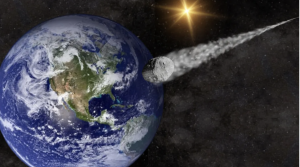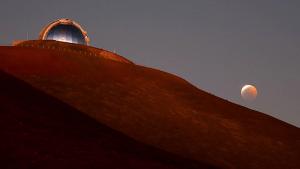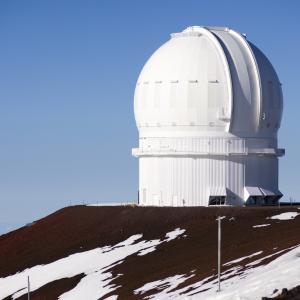VIDEO: Hawaiʻi telescopes eye asteroid’s possible impact
University of Hawaiʻi at MānoaLink to video (details below): https://go.hawaii.edu/bCr
***VO script below for consideration***
A fairly large asteroid discovered by a University of Hawaiʻi-operated telescope may impact the Earth. The historic asteroid, 2024 YR4, was first detected by UH’s Asteroid Terrestrial-impact Last Alert System (ATLAS) in December 2024 as it flew past the Earth. Estimated to be the size of a 20-story building, the asteroid is currently 27 million miles away and returns to Earth’s vicinity every 4 years. While it is expected to safely pass Earth in 2028, scientists warn that a collision in December 2032 remains a possibility.
NASA’s Center for Near Earth Object Studies estimates a 1% chance that asteroid 2024 YR4 could collide with Earth in 2032, based on current observations. Throughout the coming months, astronomers will closely monitor the 180-foot (55-meter)-wide object to refine its orbit and improve predictions of its future trajectory. No asteroid of this size has ever reached a 1% impact probability in the past two decades of near-Earth object tracking, making 2024 YR4 a rare and closely watched case.
While the odds of impact remain low, history has shown that even small asteroids can cause significant destruction. In 2013, a 65-foot (20-meter) asteroid exploded over Russia, unleashing a shock wave that shattered windows in 7,200 buildings across six cities. More than a century earlier, in 1908, an asteroid roughly the size of 2024 YR4 detonated over Tunguska, Siberia, flattening trees across nearly 1,000 square miles. Though scientists estimate a 99% chance that 2024 YR4 will safely miss Earth in 2032, its potential for impact—especially over populated areas—has drawn the close attention of the planetary defense community.
“Tiny asteroids do hit the Earth all the time, disintegrating in the atmosphere as fireballs; fortunately small ones cause little damage on the ground,” said Larry Denneau, an astronomer at UH Institute for Astronomy (IfA) and co-principal investigator at ATLAS. “Larger asteroids can cause much more damage, but they impact the Earth much less frequently. There are still many large ones out there that we haven’t found yet, which is why we are continuously monitoring the whole sky to ensure that we stay ahead of potential threats.”
Hawaiʻi telescopes monitoring
Observatories on Maunakea and Haleakalā are actively tracking 2024 YR4 to refine its trajectory. In 2022, UH was instrumental in helping track NASA’s Double Asteroid Redirection Test (DART) target asteroid system, the first successful asteroid deflection mission, proving that with enough time, an asteroid’s path can be altered to protect Earth.
Related UH News story: UH astronomers capture historic NASA spacecraft, asteroid collision, September 27, 2022
“Hawaiʻi’s telescopes are some of the most important tools for planetary defense,” said Doug Simons, director at IfA. “Thanks to our prime location and advanced technology, we can spot, track, and study asteroids with incredible accuracy. That gives scientists the time they need to evaluate potential threats and figure out the best ways to respond.”
Planetary defense
UH IfA plays a central role in planetary defense, operating some of the world’s most advanced asteroid-tracking telescopes. ATLAS, funded by NASA, is a four-telescope system located in Hawaiʻi, atop Haleakalā and Maunaloa, Chile and South Africa. It specializes in detecting asteroids on very close approaches to Earth, discovering hundreds of near-Earth objects (NEOs) each year.
IfA also operates the Panoramic Survey Telescope and Rapid Response System or Pan-STARRS on Haleakalā, the world's leading NEO discovery telescope, which is equipped to detect potentially dangerous asteroids while they are still far from Earth. As scientists continue to assess the risk posed by this asteroid, Pan-STARRS remains actively engaged in tracking its movements and refining its projected trajectory. Each year, the ground-based telescope response system on Maui tracks more than half of the near-Earth objects larger than 140 meters detected globally.
On Maunakea, two UH-operated telescopes are also serving as key components of NASA’s planetary defense system in monitoring 2024 YR4. The Infrared Telescope Facility or IRTF, a 3.2-meter NASA-funded observatory, specializes in studying near-Earth objects NEOs to evaluate potential impact risks. Meanwhile, the UH88 telescope aids in forecasting the future trajectories of these space bodies.
IfA astronomers plan to turn to the Canada-France-Hawai‘i Telescope on Maunakea in mid February for follow-up observations. The team will use the facility’s powerful MegaCam, a wide field optical camera that takes an image over a 1 deg x 1 deg field of view on the sky, roughly equivalent to the area of four full moons. MegaCam is reknowned for its cutting-edge capabilities in asteroid-tracking and deep-sky imaging.
“CFHT works closely with astronomers at IfA on a regular basis to follow-up observations made by UH facilities on Maunakea and across Hawaiʻi,” said Heather Flewelling, an instrument support scientist at CFHT. “The close collaboration facilitated the discovery of ʻOumuamua in 2017 and we look forward to observing 2024 YR4 for IfA astronomers while they better determine the orbit.”
The search for NEOs is funded by NASA’s Planetary Defense Coordination Office through its Near-Earth Object Observations Program.
Link to video (details below): https://go.hawaii.edu/bCr
B-ROLL: (37 seconds)
:00-:05 Generic illustration of an asteroid (Credit: Space.com)
:05-:08 GIF of the asteroid first discovered by ATLAS in December 2024
:09-:14 File, Wide of telescopes on Maunakea
:15-:24 UH88 telescope on Maunakea
:25-:30 IRTF on Maunakea
:31-:37 Pan-STARRS on Haleakalā
VO SCRIPT
INTRO
University of Hawaiʻi astronomers are using world-class telescopes to track a newly discovered asteroid that could pass dangerously close to Earth in 2032.
VO
The asteroid, 2024 YR4, is currently 27 million miles away. Scientists say there’s a 1% chance it could impact Earth. At 180 feet wide, it’s about the size of a 20-story building. While there’s no immediate danger, telescopes on Maunakea and Haleakalā are helping track and refine predictions. The asteroid was first detected in December by UH’s ATLAS telescope.



